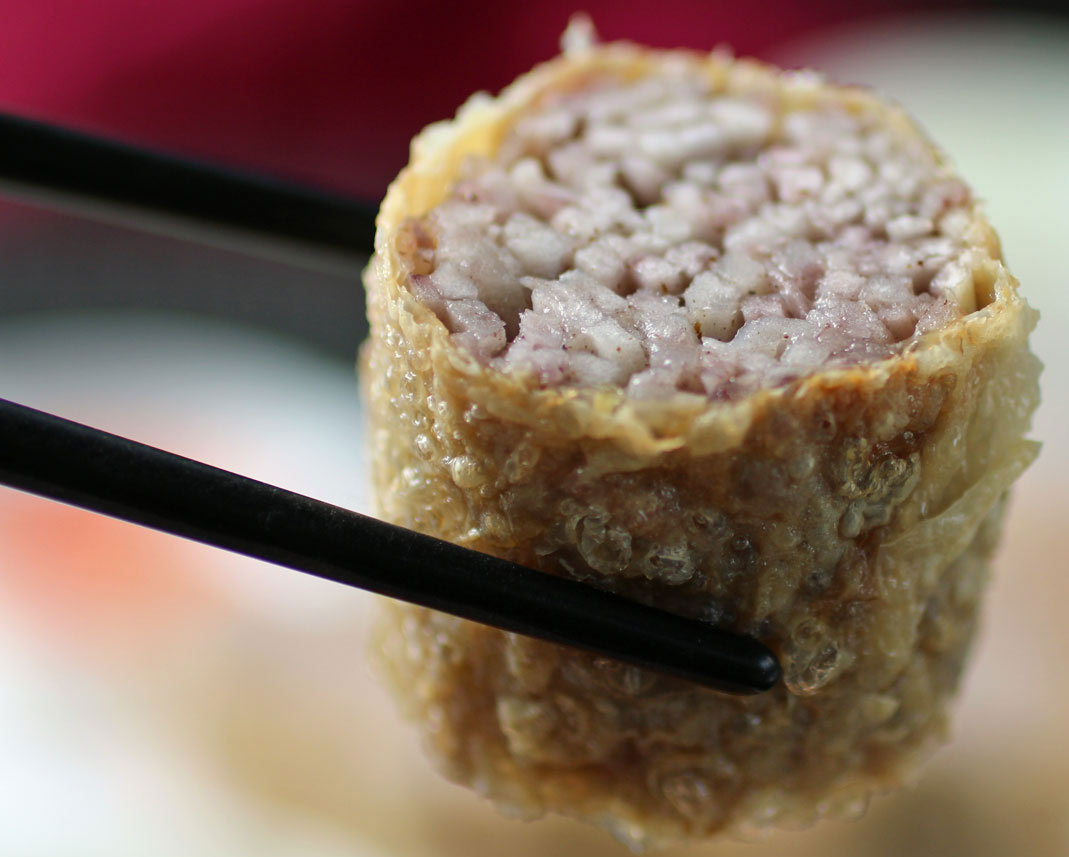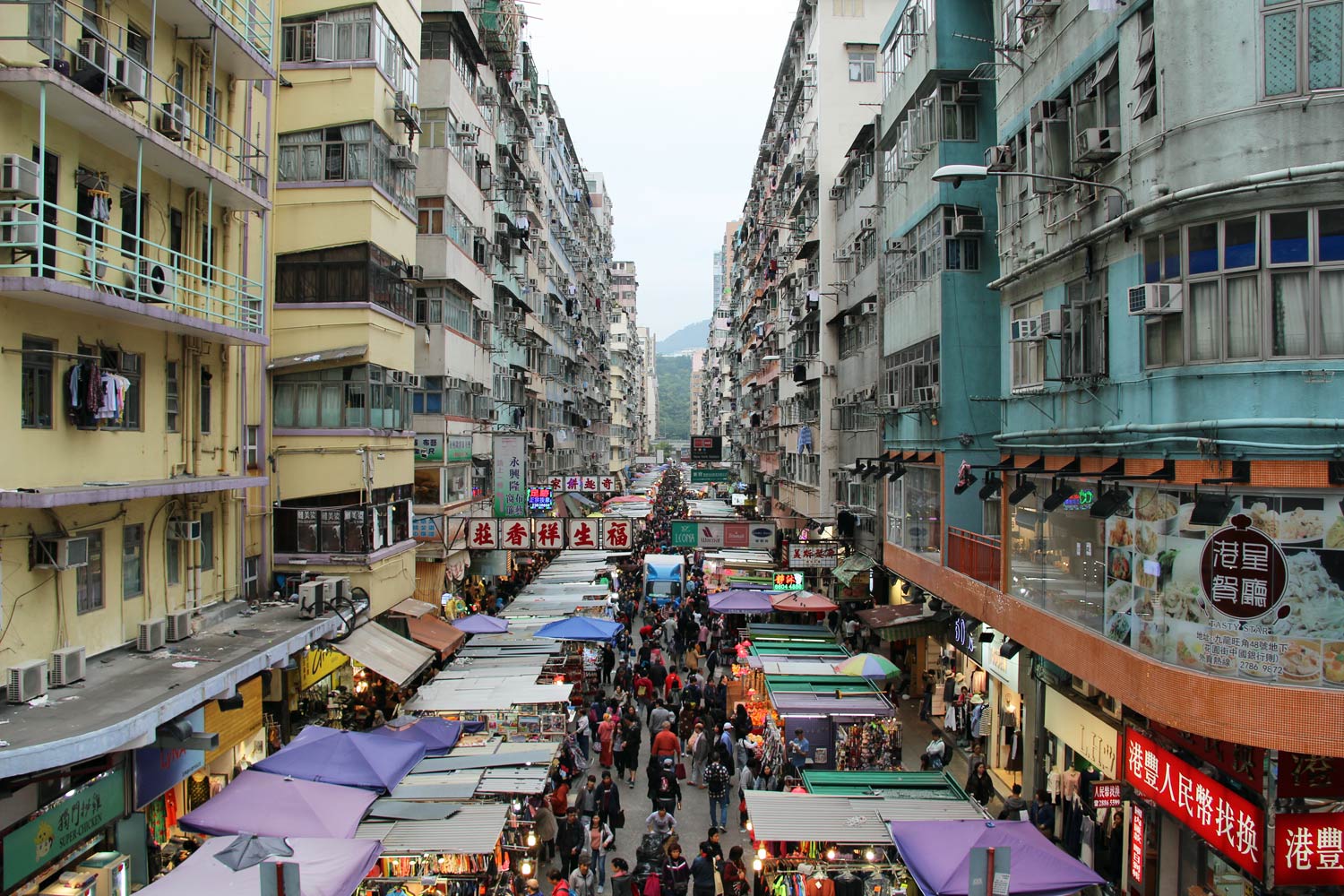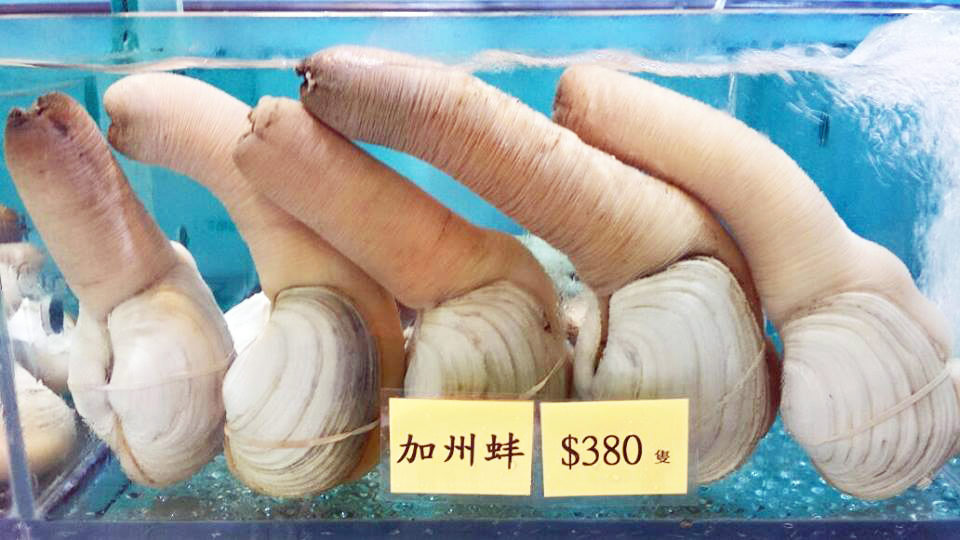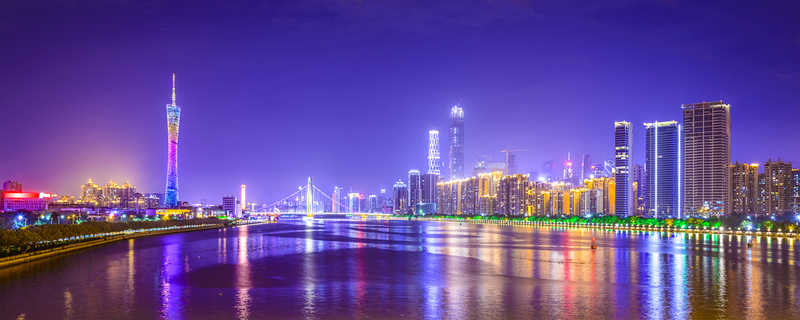
1558267200000
The Best Ways to Travel from Hong Kong to Guangzhou
What is the best way to travel from Hong Kong to Guangzhou - Here are the 4 best!

1557748800000
Where to find the Best Dim Sum in Guangzhou
In Guangzhou you are spoilt for choice when in comes to Dim Sum. With a mixture of both traditional and contemporary varieties, fresh ingredients and highly skilled chefs, you will find quality and diversity that far exceeds other cities.
Here is a list of our favourite places for Yum Cha in Guangzhou!

1524147188000
Things to do in Mongkok | An Insiders Guide
Mongkok, insanely overcrowded, humid as hell and full of great things to do. For shoppers, Mongkok has both luxury malls and street markets. For foodies, Mongkok may be the highlight of your trip to Hong Kong with abundant street food, desserts and local eateries. Enjoy our insiders guide to Mongkok.

1503466234000
Hong Kong Street Eats | The best Street Food in Hong Kong
Cantonese people love to eat, and Hong Kongs street food reflects that. With a mixture of traditional cantonese snacks and contemporary delicacies, the street food is so good that the Michelin guide for Hong Kong included a street food category since 2016. Whilst in the 1950s & 60s Hong Kong streets were studded with street food hawkers selling from carts, today you are more likely to find your favourite street food being sold from small shops and stands on street corners. Take yourself on your own eating adventure around Hong Kong sampling some of the snacks below, or join one of our Hong Kong food tours. Egg Waffles (Gai Daan Zai)Gai daan zai, or Egg Waffles are one of the most popular Hong Kong street snacks. Made from a batter of egg, wheat flour, evaporated milk, and sugar, these are a locals favourite. You’ll encounter its sweet, tempting scent often as you wander the city streets.Besides the traditional flavour egg waffle, you can now find all sorts of modern variations including Pandan and Chocolate flavours, or served with ice cream, and even our favourite, peanut butter with condensed milk!Where to find Hong Kong Egg Waffles? It is easy to find gai daan zai in Hong Kong, but lots of it will be soft, soggy or not tasty. If you want to try one of the best versions in the city, head to Lei Kung Kee (492 Kings Rd., North Point), a hole-in-the-wall near North Point MTR. Expect long queues in the afternoon. Dao fu faDao fu fa is a popular snack in Hong Kong. Made from coagulated soybean milk—essentially very soft tofu—it can be eaten hot or cold and is normally served with a sweet sugar or ginger syrup. Sometimes it is also served with fruit or mixed with black sesame paste. Good-quality dao fu fa should be soft and silky-smooth.Where to try dao fu fa? The tofu at A1 Tofu Company (103 Kweilin St., Sham Shui Po, Kowloon, Hong Kong) is made from organic Canadian soybeans, and is known for having exceptionally great texture. Pig Intestines (Ja Zu Da Cheung)Pig Intestines. Doesn’t the name just make you salivate? Probably not, but this is a popular street snack in Hong Kong. It is a labour intensive and time consuming process to prepare these intestines. First they need to be cleaned with salt and flour, boiled for an hour, coat with malt sugar and dry for 3 hours before putting them in the deep-fryer. You can hide the flavour with some mustard or hoisin sauce. The intestines themselves are a bit chewy, in some ways like squid. Just hope that your intestines were cleaned properly before being deep fried!You can find pig intestines at any of the street snack stalls that you find scattered around Hong Kong. Try Mongkok or Sham Shui Po for your culinary adventure. Curry Fish Balls (Ga Lei Yu Dan)Curry fish balls is one of the best known Hong Kong Street Foods, and can be found throughout the city. In Cantonese these are literally called “Fish Eggs”, and are 5 – 7 small balls of minced fish mixed with flour and boiled in a spicy curry sauce. Served on a bamboo skewer, they are cheap, flavoursome and easy to find. These are so popular that you can even buy them at 7-eleven. If you are interested in trying Curry Fish Balls, this Hong Kong street snack that has been a staple over the generations is one of the tastings on our Kowloon Food Tour.Where to try it Hong Kong curry fish balls?The best is from Lam Kee hidden in Hung Hom Cha Kwun Lei. They have been around for many years and expect long queues during lunch and after school hours. Their old-styled traditional sauce made from oyster sauce, dark soy sauce, star anise and curry. HKD$7 for 6 fish balls. Stinky Tofu (Cau Dou Fu)Stinky tofu is fermented tofu that can be found as a street food in Hong Kong. This weird food has its origins in mainland China, but can also be found in Hong Kong and Taiwan. The Taiwanese are especially fond of this pungent food, serving more varieties than you can find in Hong Kong.The stink in the stinky tofu is from a fermented brine made from fermented milk, vegetables, meat and shrimp. Fresh tofu is immersed in the brine for a day or two to get its flavour. The smell of stinky tofu is quite overpowering. It reminds me of the open sewers in Africa. You will need to overcome your natural instinct not to eat food with a rotten smell to try this snack.In Hong Kong stinky tofu is normally deep fried and served with hoisin sauce. In the past, stinky tofu was sold in street carts in busy areas like Mong Kok. Nowadays, you can find them in these little street side snack food shops dotted around the city. Fried Squid (Ja Yao Yu)Who doesn’t like some fried squid? The best fried squids are ones that are lightly battered, deep fried in oil over 180 degrees resulting in really crispy coating and crunchy squid inside. Kai Kei Snack (41 Dundas Street, Mong Kok) is a locals favourite for fried squid. Pineapple Buns (Bo Lo Bao)Pineapple buns are a sweet bun that is popular in Cantonese bakeries around the world. The pineapple buns actually contains no pineapple but got its name from the appearance of the sugary crust on top of the bun which has a pattern like pineapple skin.It may just be a simple bun, but it was listed by the Hong Kong Government as part of Hong Kong’s intangible heritage in 2014.Traditional pineapple buns contain no filling, but common variations include a red bean paste filling, or even real pineapple.Many Hong Kong restaurants, such as , offer an item called a buttered pineapple bun, which is a pineapple bun with a piece of butter stuffed inside. They are known in Cantonese as bo lo yau (菠蘿油), which translates literally to pineapple oil.In our humble opinion though, the best pineapple buns are found across the border in Guangzhou. Try Bing Sheng for their famous oversized buns with a pineapple filling.In Hong Kong we recommend Kam Wah Restaurant (47 Buke Street, Mongkok), their famous hot Bo Lo Yau (HKD$10) will live up to your expectations. Crunchy crust, soft bun and butter that melts as soon as you put the bun into your month. Lo Po Bang (Wife Cakes)Lo Po Bang or Wives Cakes is one of the most popular traditional pastries in Hong Kong. Originating from Guangdong in mainland China. The paste is a sweet mash of wintermelon, sugar and glutinous rice flour. We like our Lo Po Bang to have a good amount of wintermelon inside, the paste should be smooth and the pastry soft and flaky.There is a beautiful legend behind the origins of Lo Po Bang. It is said to have been invented by a man living in a small village in China. His father was terminally ill, and the man and his wife had spent all their money on trying to find a treatment to save the father. In the ultimate self sacrifice, the wife sold herself into slavery to raise more money to save her father in law. After the husband learned of his wife’s actions, he invented Lo Po Bang and sold enough to buy back his wife and save his father.You can find Lo Po Bang in most bakeries in Hong Kong, however the quality varies enormously and some to be honest are unpalatable.To try some great Lo Po Bang in Hong Kong, head out to Hang Heung Cake Shop in Yuen Long, 66 Castle Peak Road, Yuen Long, Hong Kong Lo Mai Chi (Glutinious Rice Balls)Lo Mai Chi are sweet glutinous rice ball. They sometimes have dried coconut on the outside and can be made from a variety of fillings including red bean paste, mango and durian. There are also more modern varieties with chocolate fillings.In Hong Kong you will find small speciality shops that sell freshly made Lo Mai Chi. The English name for these is often written as Nuomici, which Mandarin, not Cantonese.Lo Mai Chi are similar to Japanese Mochi, but the glutinous rice is softer and more sticky.Cheung Chau, one of the outlying island of Hong Kong is famous for Lo Mai Chi. Yong Xing Dessert place (3 Sun Hing Street, Cheung Chau) makes one of the best mango lo mai chi. Dragon Beard Candy (Long So Tong)Dragon beard candy is a traditional Chinese candy that you can find in Hong Kong. It is similar to fairy floss. The process of making the candy is often used by street sellers to attract customers, as the art of making it is in itself eye-catching. Dragon beard candy has a history of more than 2000 years in China. In the past, royal chefs in China would give a performance on how to make dragon beard candy in front of guests and serve them afterwards.Made primarily from maltose and sugar, after stretching the strands are rolled around peanuts, sesame seads, it has a stringy appearance with a rich sweet flavour and will melt on your tongue.The candy is best eaten freshly made and will quickly melt in warmer weather.Where to find Dragon Beard Candy?Dragon beard candy is not easy to find. You might be lucky to stumble upon it at a night market or festival. Otherwise there is a small shop in Sheung Wan near the MTR Exit B that sells it. Look for a Chinese sign with small writing that says “Super Bowl King Traditional Sweets and Desserts” Three Stuffed Treasures (Jin yeung saam bo)Three stuffed treasures is a street snack that has it’s origins in Shunde in Guangdong. You may have actually tried variations of this street snack in dim sum restaurants without even knowing it. Traditional three stuffed treasures comprises bitter melon, long green chili and eggplant. Each is stuffed with fish paste. When you buy this from a street vendor in Hong Kong, there are actually more than 3 varieties to choose from with other options including stuffed tofu, stuffed mushrooms and even sausages, The vendor will stick a piece of each chosen variety on a bamboo skewer and deep fry them. Be wary of food safety if buying this on the street, as it may have been sitting out all day.To try three stuffed treasures, you need to go to a stall that makes them in the original way – deep fried in pork oil. Nowadays, people are very health conscious and will run away as soon as they hear the word “pork oil”. Luckily, there is Dong Hing Snack Food in Stall A4, 43-59 Dai Tsuen Street, Tai Kok Tsui that makes their own pork oil, beat their own fish mince and the smell spreads throughout the whole street. Beef Offal Stew (ngao tsap)Slow cooked beef offal, boiled for hours in a master stock that may have been used for years. Fresh beef is also included in the soup. Our favourite part is the honeycomb tripe, but you will also find small intestines, large intestinese and lungs in this delicious delicacy. Try to find a vendor that includes some white radish, which will soak up the flavour of the soup.In the past is was possible to find this being sold be street vendors in Hong Kong, but with an ever reducing number of street vendors, you are likely going to have to go to a restaurant for this street food.Where to try beef offal stew?Sui Kee 2, Gutzlaff Street, Central, Hong KongThis famous beef offal and beef brisket stew place has been around for more than 60 years. It has been passed down to three generations but owner Li said his only son is not as tough as he is and simply not interested in spending up to 15 hours in the stall. So, enjoy it while you can! Wun Jai Ci – “shark fin” soupIn the 40’s, around Temple Street Yau Ma Tei area, there were street sellers that gathered left over shark fins from restaurants and recooked them in a nice thick soup so that common people can also enjoy shark fins.Due to increased hygiene standards, vendors don’t use leftovers anymore and they have replaced the shark fin with vermicelli. Cooked with black fungus, mushrooms, shredded chicken meat, cured ham, this tasty and filling soup is a great snack to have.Where to try imitation shark fin soup?Bon Bon Cafe92 Ivy Street, Tai Kok Tsui, Hong Kong Boot zai go – steamed glutinous rice pudding Originated from Tai Shan in Guangdong, it is made from brown sugar and glutinous rice flour, steamed in porcelain small bowls, often with red beans inside. In the past these were sometimes served by street vendors skewered on two bamboo sticks.Where to try boot zai go?Kwon Kee, 115-117 Fook Wah Street Sham Shui Po, Hong Kong

1501583492000
The Ultimate Weird Food Guide to Hong Kong | 15 Weird Eats from the Eating Adventures team
The Eating Adventures team loves exploring Hong Kong to find the weirdest and tastiest food. Here is the our ultimate guide of 15 of the weirdest foods that you can find in Hong Kong. Turtle jelly, snake soup, chicken testicles, geoduck, horse sashimi and more!

1561347680000
144 hour visa free transit for Guangzhou and Shenzhen
Are you considering a layover in Guangzhou or Shenzhen? Well now you may be able to visit enjoy a visa free transit for up to 144 hours! Starting from 1st May 2019, travellers from 53 countries can transit through Guangdong province, China to a third country or region without buying a Chinese via. You will probably find this most useful for China Southern layovers when flying into Guangzhou or Shenzhen international airports, but the rules are actually a bit more flexible than that. Who is eligible for the 144-hour visa free transit in Guangdong China? Travellers from one of the 53 eligible countries listed below can take a visa free transit in Guangzhou, Zhenshen and the rest of Guangdong province: Schengen area countries: Austria, Belgium, Czech Republic, Denmark, Estonia, Finland, France, Germany, Greece, Hungary, Iceland, Italy, Latvia, Lithuania, Luxembourg, Malta, Netherlands, Poland, Portugal, Slovakia, Slovenia, Spain, Sweden, SwitzerlandOther countries in Europe: Russia, the United Kingdom, Ireland, Cyprus, Bulgaria, Romania, Ukraine, Serbia, Croatia, Bosnia-Herzegovina, Montenegro, Macedonia (FYROM), Albania, Monaco, BelarusNorth and South America: the United States, Canada, Brazil, Mexico, Argentina, ChileOceania: Australia, New ZealandAsia: Korea, Japan, Singapore, BruneiMiddle East: United Arab Emirates, QatarWhere must you enter for a visa free transit in Guangdong, China?You will need to enter from one of the three ports – Guangzhou Baiyun Airport Shenzhen Bao’an Airport Jieyang Chaoshan Airport and importantly, you must hold a confirmed onward ticket to a third country or region. Hong Kong and Macau are considered as third territories. Where must you exit on a visa free transit in Guangdong, China?If you want to get a 144 hour visa free transit for Guangzhou, Shenzhen or anywhere else in Guangdong, China, you will need to exit from one of the 32 designated ports –AirportsGuangzhou Baiyun AirportShenzhen Baoan AirportJieyang Chaoshan AirportMeizhou AirportZhejiang AirportRailway stationsGuangzhou Tianhe – Guangzhou East Railway StationDongguan – Changping Railway StationFoshan – Foshan Railway StationZhaoqing – Zhaoqing Railway StationLand portsShenzhen: Shatoujiao, Wenjindu, Huanggang, Luohu, Shenzhen Bay, Futian Zhuhai: Gongbei, HengqinSea portsGuangzhou: Port of Guangzhou, Nansha Port, Lianhuashan PortShenzhen: Shekou Port, Fuyong Port (in Shenzhen airport)Zhuhai: Jiuzhou Port, Wanzai Port, Wanshan Port, Doumen PortJiangmen: Port of JiangmenHeshan: Port of HeshanFoshan: Gaoming Port, Ronqi Port Zhongshan: Port of Zhongshan Dongguan: Humen Port How does this differ to the previous 72 hour visa free entry?Previously, foreigners from 45 countries were able to get a 72 hour visa free entry. However this was restricted to entering and exiting from Guangzhou Baiyun Airport. How do I apply for the 144-hour Temporary Entry Permit to Guangdong?Upon arrival at the airport, go to Temporary Entry Permit Application counter.Fill in the application form.Present your passport which needs to have more than 3 month validity and a confirmed onward ticket to a third country or region. Please note that both flights must have no stopovers of any kind within Mainland China. Where can I travel on a 144 hour visa free entry and how long can I stay?The 6-day stay starts from midnight the day following the date of arrival. You are allowed to travel anywhere within Guangdong province (this includes, Guangzhou, Shenzhen, Foshan, Dongguan, Zhuhai, Jiangmen, Qingyuan and many smaller cities).Chinese visa rules can change rapidly. Please check with your local Chinese consulate prior to travel. Don't travel without a visa just because we said you could! About Eating AdventuresEating Adventures offers walking food tours in Guangzhou. Explore the backstreets of Guangzhou and gain an appreciation for this fantastic city and its world famous chinese cuisine. Guangzhou tours led by true local licensed tour guides (strictly no expats, no unlicensed guides). All our guides are fluent in Cantonese, the local dialect.If you are looking for inspiration for what to do on a stopover, check out our Guangzhou Travel Guide. Dont forget, you cannot access Google, Facebook and Whatsapp in China, so you might need to purchase a VPN connection prior to travel to get around this. We use Panda VPN.
15 Weird foods to EAT in HOng Kong | The ultimate weird food guide for HK

When we are not running food tours in Hong Kong, the Eating Adventures team loves exploring Hong Kong to find the weirdest and most exotic food. Here is the our ultimate guide of 15 of the weirdest foods that you can find in Hong Kong.
BIRD NEST SOUP
Birds nest soup is one of the most expensive exotic delicacies that you can eat in Hong Kong. The nest itself is actually solidified saliva from male Swiflets. The nest are normally used to make a soup and are prized for their high nutritional value. Bird nest soup can either be sweet or savoury and should not be prepared with anything that has a strong flavour so as to appreciate the delicate flavour of the bird nest.
When dissolved in water the birds nest has a gelatinous texture. The colour of the nest varies with quality, with the purest white nests being the most expensive.
We have had the good fortune of trying high quality bird nest in a sweet soup dessert and highly recommend it!
Buying birds nest from speciality shops for home cooking costs around HKD150 to HKD500 per gram.
If you are interested in trying birds nest in a restaurant here are two options:
Tin Ngai Kam Bird Nest Place (G/F, 210 Shanghai Street, Yau Ma Tei) – A small no-frills place specialising in medicinal soups and birds nest, their small soup costs HKD238.
Shang Palace, a 2 Michelin-star Cantonese restaurant inside the Shangri-La Hotel, their bird nest soup costs HKD680-HKD720 per person.
STINKY TOFU
Stinky tofu is fermented tofu that can be found as a street food in Hong Kong. This weird food has its origins in mainland China, but can also be found in Hong Kong and Taiwan. The Taiwanese are especially fond of this pungent food, serving more varieties than you can find in Hong Kong.
The stink in the stinky tofu is from a fermented brine made from fermented milk, vegetables, meat and shrimp. Fresh tofu is immersed in the brine for a day or two to get its flavour. The smell of stinky tofu is quite overpowering. It reminds me of the open sewers in Africa. You will need to overcome your natural instinct not to eat food with a rotten smell to try this snack.
In Hong Kong stinky tofu is normally deep fried and served with hoisin sauce. In the past, stinky tofu was sold in street carts in busy areas like Mong Kok. Nowadays, you can find them in these little street side snack food shops dotted around the city.
CENTURY EGG
How about some egg that has been cured in horse urine?
Century egg is also known as hundred year eggs or thousand year eggs. It can be prepared from duck, quail or chicken eggs that are preserved in a mixture of clay, ash, quicklime and ricehulls. After preservation, the egg white will turn a translucent brown colour and the egg yolk will turn dark green or grey.
Common ways you will find century egg in Hong Kong is either served in congee, or with garlic, chilli and vinegar sprinkled on top. You can also have century egg without further preparation.
Century egg has a subtle flavour and the Chinese believe it is a good hangover cure.
And sorry to disappoint, but despite many people believing that century egg is cured in horse urine because of the smell, there is actually no urine involved.
BLOOD TOFU
Blood tofu is definitely one of the weirdest foods in Hong Kong. It is coagulated fresh pigs blood that has been solidified into cubes by heating and adding salt. It has a soft and smooth texture and you will commonly find it either being eaten as a dish by itself in a soy broth or in congee. If you are lucky, you may also come across duck blood tofu. The taste, as you would expect is like you are eating blood.
Blood tofu is a Cantonese speciality that has its origins in southern china in poorer times when food was scarcer. It is rich in a range of vitamins and minerals including vitamin C, iron, calcium and niacin. Excessive consumption can cause iron poisoning, so don’t eat it more than a couple of times a week.
TURTLE JELLY
Turtle Jelly is a Chinese medicine that is sold as a dessert. It is believed to be good for your skin, as well as improving circulation, reducing acne and assisting your kidneys.
Traditionally it should be made from powdered plastron (the lower turtle shell) combined with a mixture of Chinese herbs. Due to the high cost of turtles, some turtle Jelly being sold in Hong Kong has been found to contain no turtle at all, so if you want to try this, check with your concierge for a reputable shop.
Turtle Jelly is an acquired taste, slightly bitter and can be sweetened by adding some syrup.
Turtle Jelly is normally sold by the same shops as sell herbal tea, and you can expect it to cost around HKD50 per portion. One famous place to try turtle Jelly is Gong Wo Tong in Jordan (15 We Chong Street)
SNAKE SOUP
Snake soup is a true Cantonese delicacy and one of the favourite tastings on our Kowloon Food Tour. Don’t be put off by the idea of eating snake—this soup is surprisingly tasty and not scary at all! It typically contains two types of snakes, some of which are venomous, and is thick with a complex flavour comprising, among other things, ginger, lemon leaves, fungus, and sometimes star anise. While the snake meat itself tastes like chicken, it is the flavour of the soup that will keep you coming back for more.
Because the Chinese believe this soup to be warming, it is particularly popular in winter, but you can find it year-round. It’s said to be good for circulation
RAW HORSE MEAT
Horse meat sashimi or Basashi is not a Cantonese speciality. This exotic delicacy originating in Japan is one of the more interesting imported foodie experiences you can try in Hong Kong. The meat gets frozen first to kill bacteria and then is served cold along with soy sauce, garlic and wasabi.
Horse meat is rich in protein, zinc, iron, and vitamin B, as well as low in fat.
If you want to try this Japanese delicacy while you are in Hong Kong, try Seki Tei Japanese restaurant in Tsim sha Tsui.
CHICKEN TESTICLES
Chicken testicles are one of the less appealing weird foods that you may find on a menu in Hong Kong. They may be added to a hot pot, deep fried or boiled. The texture is a bit like soft tofu and the flavour is more like liver.
Chicken testicles as a dish originated from the Hakka area of Guangdong province. In restaurants they call these “Hens’ eggs”. It is meant to be good for women’s skin and for men’s kidneys.
GEODUCK
Geoduck (pronounced Goo-ey-duck) its the largest burrowing clam in the world. They originate from the west coast of Canada and the USA and are sold live in markets wet markets in Hong Kong. Geoducks take 6 years to reach maturity and can live for an amazing 140 years, although life expectancy is considerably shorter for those in Hong Kong Restaurants! A single Geoduck can weigh around 1.5 pounds.Lots of high end seafood restaurants in Hong Kong will have live Geoduck on display. Alternatively you can always find fresh Geoduck on display at the Mongkok wet markets. Expect to pay around 180HKD per pound for this rare delicacy. The best way to prepare geoduck is to quickly boil them in hot water then dip into ice cold water. Sprinkle with shallot, ginger and chilli, drizzle with soy and cooked oil.
If you would like to go to a Geoduck speciality shop, you can try Sek Tek Guo in Tun Mun.
SEA CUCUMBER
Sea cucumber is a marine delicacy in Hong Kong, and despite the name, is not a vegetable. They are commonly dried for preservation and then rehydrated by soaking in water prior to cooking, although you can also find them fresh. They are prepared numerous was including in soups, steamed, deep fried, and even in Cheung fun (rice rolls). Prices can vary depending on type and quality, with the rare white sea cucumbers costing up to $80 per gram.
This is one of our favourite delicacies, and we highly recommend it!
DURIAN
Durian. Where to begin? Definitely the most delicious fruit in our opinion, and possibly one of the tastiest foods you can eat in Hong Kong. The flavour varies depending on the variety, but think of it as some sort of delicious mix between avocado and custard. The texture should be soft and creamy. If the flesh is hard it means that it is not ripe yet. Durian is not grown in Hong Kong, so it is all imported from Thailand and Malaysia. During durian season it is easy to find durian being sold in the supermarkets and fruit stalls around Hong Kong. Prices vary depending on the breed of durian and quality. Look for a durian that still has a green shell, has not opened yet and has a strong sweet smell.
SNAKE WINE
Snake wine is made from infusing whole snakes in rice wine. The snakes used for this are often venomous. Whole live snakes are placed inside jars, along with Chinese herbs, and sometimes other animals such as lizard. The wine is then left absorb the essence of the snake for several months or even longer.
The wine has a high alcohol content, and would normally be consumed as a shot. The venom from the snake is no longer dangerous after mixing with the alcohol, and the rice wine is thought to have many medicinal benefits including being anti-inflammatory and preventing hair loss.
One of the risks of snake wine is that the snake inside the bottle is not dead. There have been several cases in china of people opening a bottle after it has been left to mature only to be bitten by an angry snake.
PIG BRAIN
Pig’s brain has higher content of calcium, magnesium and iron compared to pork, however, it is extremely high in cholesterol. It is also not recommended for men but it is used as a Chinese medical for headache and insomnia. Commonly cooked in soup with other Chinese Herbs .
BULL TESTICLES
Another exotic treat in Hong Kong that is not a Cantonese speciality. Head down to Crafty Cow in Sheung Wan for some Panko Crusted bull testicles. With a more gamey flavour than beef, some people say they taste a bit like venison. Bull testicles are high in protein, vitamins and minerals.
JELLY FISH SALAD
You will never imagine but jellyfish makes a good refreshing salad in summer. Jellyfish is soaked in cold water first then gets boiled in water for 10-15 minutes before rinsing under cold water. Mixed with shredded cucumber, coriander, drizzled with soy sauce, vinegar, sesame seeds and chilli oil, the jelly fish itself is very bouncy. In fact, Hong Kong kids call them “rubber bands”.